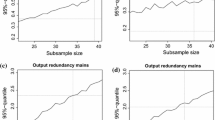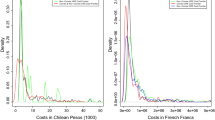Abstract
Economies of scope are typically modelled and estimated using a cost function that is common to all firms in an industry irrespective of their type, e.g. whether they specialize in a single output or produce multiple outputs. Instead, we estimate a flexible technology model that allows for type-specific technologies and show how it can be estimated using linear parametric forms including the translog. A common technology remains a special case of our model and is testable econometrically. Our sample, of publicly owned US electric utilities, does not support a common technology for integrated and specialized firms. Our empirical results therefore suggest that assuming a common technology might bias estimates of economies of scale and scope. Thus, how we model the production technology clearly influences the policy conclusions we draw from its characteristics.
Similar content being viewed by others
Notes
Duality theory allows us to estimate the underlying production technology via a cost function. Duality theory and the implied restrictions on the cost function ensure that the latter does not violate the physics of production. For an introduction see the survey by Fuss and McFadden (1978).
For notational convenience and ease of exposition, we do not index input prices by utility type.
Although we are using notations y U and y D these can be generically labeled as y 1 and y 2 so that y U and y D for the integrated firm are nothing but y 1 and y 2.
We thank an anonymous referee for making this point.
In the interest of brevity, we do not report the coefficient estimates for the models that define the distribution output as power delivered. They are available upon request. In any case, Table 4 below shows the scale and scopes estimates for both distribution output specifications.
References
Akridge JT, Hertel TW (1986) Multiproduct cost relationships for retail fertilizer plants. Am J Agric Econ 68:928–938
Arocena P, Saal D, Coelli T (2012) Vertical and horizontal scope economies in the regulated US electric power industry. J Ind Econ 60(3):434–467
Battese G (1997) A note on the estimation of Cobb–Douglas production functions when some explanatory variables have zero values. J Agric Econ 48(2):250–252
Battese G, Malik SJ, Gill MA (1996) An investigation of technical inefficiencies of production of wheat farmers in four districts of Pakistan. J Agric Econ 47(2):37–49
Baumol W, Panzar JC, Willig R (1982) Contestable markets and the theory of industry structure. Harcourt Brace Jovanovich, San Diego
Berger AN, Hanweck GA, Humphrey DB (1987) Competitive viability in banking: scale, scope, and product mix economies. J Monet Econ 20(3):501–520
Berndt ER, Khaled MS (1979) Parametric productivity measurement and choice among flexible functional forms. J Polit Econ 87(6):1220–1245
Bottasso A, Conti M, Piacenz M, Vannoni D (2011) The appropriateness of the poolability assumption for multiproduct technologies: evidence from the English water and sewerage utilities. Int J Prod Econ 130(1):112–117
Caves DW, Christensen LR, Tretheway MW (1980) Flexible cost functions for multiproduct firms. Rev Econ Stat 62(3):477–481
Charnes A, Cooper WW, Rhodes E (1978) Measuring the efficiency of decision making units. Eur J Oper Res 2:429–444
Christensen LR, Greene H (1976) Economies of scale in the US electric power generation. J Polit Econ 84:655–677
Christensen LR, Jorgenson DW, Lau LJ (1973) Transcendental logarithmic production frontiers. Rev Econ Stat 55(1):28–45
Cowing TG, Holtmann AG (1983) Multiproduct short-run hospital cost functions: empirical evidence and policy implications from cross-section data. South Econ J 49:637–653
Färe R (1986) Addition and efficiency. Q J Econ 101(4):861–865
Fetz A, Filippini M (2010) Economies of vertical integration in the Swiss electricity sector. Energy Econ 32:1325–1330
Fraquelli G, Piacenza M, Vannoni D (2005) Cost savings from generation and distribution with an application to Italian electric utilities. J Regul Econ 28(3):289–308
Fuss MA, McFadden D (1978) Production economics: a dual approach to theory and applications. Volume I: the theory of production. North-Holland, Amsterdam
Fuss MA, Waverman L (1981) Regulation and the multi-product firm: the case of telecommunications in Canada. In: Fromm G (ed) Studies in public regulation. MIT Press, Cambridge
Fuss MA, Waverman L (2002) Econometric cost functions. In: Vogelsang CM (ed) Handbook of telecommunications economics. Volume I: structure, regulation and competition. Elsevier, Amsterdam, pp 144–177
Garcia S, Moreaux M, Reynaud A (2007) Measuring economies of vertical integration in network industries: an application to the water sector. Int J Ind Organ 25:791–820
Gilligan T, Smirlock M (1984) An empirical study of joint production and scale economies in commercial banking. J Bank Finance 8:67–76
Gilsdorf K (1994) Vertical integration efficiencies and electric utilities: a cost complementarity perspective. Q Rev Econ Finance 34(3):261–282
Goisis G, Giorgetti ML, Parravicini P, Salsano F, Tagliabue G (2009) Economies of scale and scope in the European banking sector. Int Rev Econ 56(3):227–242
Greer M (2008) A test of vertical economies for non-vertically integrated firms: the case of rural electric cooperatives. Energy Econ 30(3):679–687
Gunning TS, Sickles RC (2009) A multi-product cost function for physician private practices. J Prod Anal 35(2):119–128
Jara-Díaz S, Ramos-Real FJ (2011) The effect of output specification on the optimal policy design for electric utilities. J Regul Econ 40(1):62–81
Jara-Díaz S, Ramos-Real FJ, Martínez-Budría E (2004) Economies of integration in the Spanish electricity industry using a multistage cost function. Energy Econ 26(6):995–1013
Jin S, Rozelle S, Alston J, Huang J (2005) Economies of scale and scope and the economic efficiency of China’s agricultural research system. Int Econ Rev 46(3):1033–1057
Kaserman DL, Mayo JW (1991) The measurement of vertical economies and the efficient structure of the electric utility industry. J Ind Econ 39:483–502
Kim YH (1987) Economies of scale in multi-product firms: an empirical analysis. Economica 54(214):185–206
Kuosmanen T (2012) Stochastic semi-nonparametric frontier estimation of electricity distribution networks: application of the StoNED method in the Finnish regulatory model. Energy Econ 34(6):2189–2199
Kwoka JE (2002) Vertical economies in electric power: evidence on integration and its alternatives. Int J Ind Organ 20:653–671
Martínez-Budría E, Jara-Díaz S, Ramos-Real FJ (2003) Adapting productivity theory to the quadratic cost function: an application to the Spanish electric sector. J Prod Anal 20(2):213–229
Mayo J (1984) Multiproduct monopoly, regulation and firm costs. South Econ J 51(1):208–218
Meyer R (2012) Vertical economies and the costs of separating electricity supply—a review of theoretical and empirical literature. Energy J 33(4):161–185
Nerlove M (1963) Returns to scale in electricity supply. In: Christ CF (ed) Measurement in economics. Studies in mathematical economics and econometrics in memory of Yehuda Grunfeld. Stanford University Press, Stanford, pp 167–198
Panzar JC, Willig RD (1981) Economies of scope. Am Econ Rev 71(2):268–272
Rezvanian R, Mehdian S (2002) An examination of cost structure and production performance of commercial banks in Singapore. J Bank Finance 26:79–98
Röller L (1990) Modelling cost structure: the Bell System revisited. Appl Econ 22:1661–1674
Saal DS, Parker D (2006) Assessing the performance of water operations in the English and Welsh water industry: a lesson in the implications of inappropriately assuming a common frontier. In: Coelli T, Lawrence D (eds) Performance measurement and regulation of network utilities. Edward Elgar, Cheltenham
Weninger Q (2003) Estimating multiproduct costs when some outputs are not produced. Empir Econ 28(4):753–765
Zellner A (1962) An efficient method of estimating seemingly unrelated regressions and tests for aggregation bias. J Am Stat Assoc 57(298):348–368
Acknowledgments
We would like to thank the participants of the 39th EARIE conference in Rome for their helpful comments. The usual disclaimer applies. Pablo Arocena and David Saal acknowledge financial support from the Spanish Ministry of Economy and Competitiveness (project ECO2010-21242-C03-03).
Author information
Authors and Affiliations
Corresponding author
Rights and permissions
About this article
Cite this article
Triebs, T.P., Saal, D.S., Arocena, P. et al. Estimating economies of scale and scope with flexible technology. J Prod Anal 45, 173–186 (2016). https://doi.org/10.1007/s11123-016-0467-1
Published:
Issue Date:
DOI: https://doi.org/10.1007/s11123-016-0467-1
Keywords
- Economies of scale and scope
- Flexible technology
- Electric utilities
- Vertical integration
- Translog cost function




